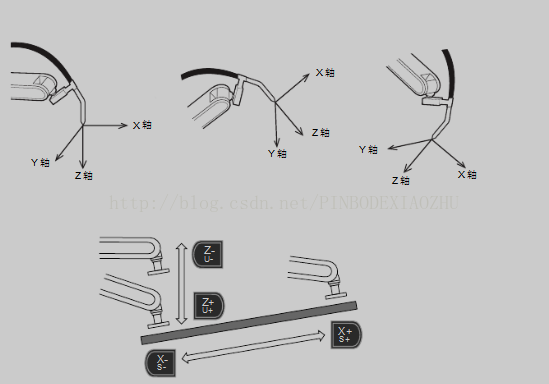### UR机器人工具坐标系标定代码示例
对于UR机器人的工具坐标系(TCP)标定,通常涉及通过一系列已知位置的姿态来计算TCP相对于末端执行器的位置和方向。此过程可以借助Python脚本以及ROS (Robot Operating System) 来实现。
下面是一个基于Python的简单示例,用于演示如何使用六个不同的姿态点来进行TCP标定:
```python
import numpy as np
from ur_robot_driver.srv import *
import rospy
def tcp_calibration(points):
"""
计算工具中心点(TCP)相对于法兰盘原点的位置向量。
参数:
points -- 包含6个不同位姿下的笛卡尔坐标列表 [[x1, y1, z1], ... , [x6, y6, z6]]
和对应的关节角度 [[j1_1, j2_1,..., j6_1], ..., [j1_6, j2_6,..., j6_6]].
返回值:
TCP_offset -- 工具中心点偏移量[x,y,z,a,b,c].
"""
service_name = '/ur_hardware_interface/set_tcp'
set_tcp_srv = rospy.ServiceProxy(service_name, SetTcp)
try:
response = set_tcp_srv(tcp=[0., 0., 0., 0., 0., 0.]) # Reset to default before calibration
A = []
B = []
for point in points:
cartesian_position = point[:3]
joint_angles = point[3:]
# Add your code here to move the robot arm according to `joint_angles` and record actual tool position
measured_tool_pos = get_measured_tool_pose() # Function that returns current tool pose from sensor data or FK calculation
A.append(cartesian_position)
B.append(measured_tool_pos)
P = np.array(A).T @ np.linalg.inv(np.array(B).T)
tx, ty, tz = P.diagonal()
rx, ry, rz = rotation_matrix_to_euler(P / P.diagonal())
TCP_offset = [tx, ty, tz, rx, ry, rz]
result = set_tcp_srv(tcp=TCP_offset)
return TCP_offset
except Exception as e:
print(f"Service call failed with error {e}")
def rotation_matrix_to_euler(R):
"""Converts a rotation matrix into Euler angles."""
sy = math.sqrt(R[0,0] * R[0,0] + R[1,0] * R[1,0])
singular = sy < 1e-6
if not singular :
x = math.atan2(R[2,1] , R[2,2])
y = math.atan2(-R[2,0], sy)
z = math.atan2(R[1,0], R[0,0])
else :
x = math.atan2(-R[1,2], R[1,1])
y = math.atan2(-R[2,0], sy)
z = 0
return np.array([x, y, z])
def get_measured_tool_pose():
"""Placeholder function representing how one would obtain real-time measurements of the tool's pose"""
pass
if __name__ == "__main__":
rospy.init_node('tcp_calibrator')
sample_points = [
[-0.4,-0.2,0.5, -90,-90,0],
...
] # Insert six different poses consisting of both Cartesian positions and corresponding joint configurations.
calibrated_TCP = tcp_calibration(sample_points)
print(calibrated_TCP)
```
上述代码展示了如何定义一个函数`tcc_calibration()`,该函数接收一组由六个不同位姿组成的输入数据集,并返回所估计出来的TCP偏移量[^1]。注意,在实际应用中,获取测量到的工具姿势(`get_measured_tool_pose`)部分应该替换为从传感器读取真实世界的数据或者正运动学计算的结果。


























 4741
4741

 被折叠的 条评论
为什么被折叠?
被折叠的 条评论
为什么被折叠?








